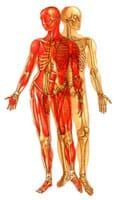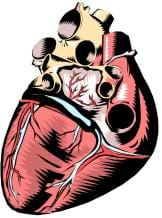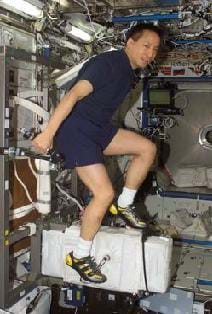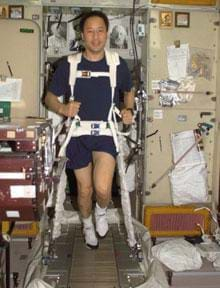Quick Look
Grade Level: 5 (3-5)
Time Required: 45 minutes
Expendable Cost/Group: US $0.00
Group Size: 4
Activity Dependency: None
Subject Areas: Biology, Earth and Space
NGSS Performance Expectations:

| 3-5-ETS1-1 |

Summary
This activity helps students learn about the three different types of muscles and how outer space affects astronauts' muscles. They will discover how important it is for astronauts to get adequate exercise both on Earth and in outer space. Also, through the design of their own microgravity exercise machine, students learn about the exercise machines that engineers design specifically for astronaut use.Engineering Connection
Engineers need to understand how the human body works in order to help astronauts stay healthy in outer space. The microgravity of outer space leads to muscle atrophy, so scientists and engineers at NASA work to design special exercise machines to help the astronauts maintain muscle strength.
Learning Objectives
After this activity, students should be able to:
- Explain the difference between skeletal, cardiac and smooth muscle.
- Explain the difference between involuntary and voluntary muscles.
- Describe what happens to astronauts' muscles in outer space.
- Relate that engineers help astronauts stay healthy in outer space by designing special exercise machines.
Educational Standards
Each TeachEngineering lesson or activity is correlated to one or more K-12 science,
technology, engineering or math (STEM) educational standards.
All 100,000+ K-12 STEM standards covered in TeachEngineering are collected, maintained and packaged by the Achievement Standards Network (ASN),
a project of D2L (www.achievementstandards.org).
In the ASN, standards are hierarchically structured: first by source; e.g., by state; within source by type; e.g., science or mathematics;
within type by subtype, then by grade, etc.
Each TeachEngineering lesson or activity is correlated to one or more K-12 science, technology, engineering or math (STEM) educational standards.
All 100,000+ K-12 STEM standards covered in TeachEngineering are collected, maintained and packaged by the Achievement Standards Network (ASN), a project of D2L (www.achievementstandards.org).
In the ASN, standards are hierarchically structured: first by source; e.g., by state; within source by type; e.g., science or mathematics; within type by subtype, then by grade, etc.
NGSS: Next Generation Science Standards - Science
| NGSS Performance Expectation | ||
|---|---|---|
|
3-5-ETS1-1. Define a simple design problem reflecting a need or a want that includes specified criteria for success and constraints on materials, time, or cost. (Grades 3 - 5) Do you agree with this alignment? |
||
| Click to view other curriculum aligned to this Performance Expectation | ||
| This activity focuses on the following Three Dimensional Learning aspects of NGSS: | ||
| Science & Engineering Practices | Disciplinary Core Ideas | Crosscutting Concepts |
| Define a simple design problem that can be solved through the development of an object, tool, process, or system and includes several criteria for success and constraints on materials, time, or cost. Alignment agreement: Obtain and combine information from books and/or other reliable media to explain phenomena or solutions to a design problem.Alignment agreement: | Possible solutions to a problem are limited by available materials and resources (constraints). The success of a designed solution is determined by considering the desired features of a solution (criteria). Different proposals for solutions can be compared on the basis of how well each one meets the specified criteria for success or how well each takes the constraints into account. Alignment agreement: | People's needs and wants change over time, as do their demands for new and improved technologies. Alignment agreement: |
International Technology and Engineering Educators Association - Technology
-
Students will develop an understanding of the attributes of design.
(Grades
K -
12)
More Details
Do you agree with this alignment?
-
Technological advances have made it possible to create new devices, to repair or replace certain parts of the body, and to provide a means for mobility.
(Grades
3 -
5)
More Details
Do you agree with this alignment?
State Standards
Colorado - Science
-
Assess further scientific explanations regarding basic human body system functions
(Grade
5)
More Details
Do you agree with this alignment?
Materials List
Each group needs:
- Pencils
- Paper
- Crayons
- Books with images of muscle cells and/or muscle cell slides and microscope
Introduction/Motivation
Muscles can be classified in many ways. Can you name a muscle? Well, the heart is a muscle! This muscle is called cardiac muscle. 
Skeletal muscles are some of our largest and most powerful muscles, (like our biceps, triceps, and quadriceps), and they are connected to our bones with tendons. Skeletal muscles are the only muscles that are voluntary. Voluntary means the opposite of involuntary. If we think about it, we can do it. Close your eyes again, and tell your arm to move so you are raising your hand. No open your eyes. Did you raise your hand? Yes, you did! That is because skeletal muscles are voluntary muscles!
When astronauts travel into outer space, they live in a microgravity environment, or a place with less gravity than on Earth. Gravity on Earth is what holds on the ground and keeps us from floating away. That is why we see pictures of astronauts floating around in space, because there is little gravity to hold them in place. Since there is almost no gravity in outer space, astronauts' muscles do not work as hard as they do on Earth (i.e., through general, daily movement). This leads to muscle atrophy, which means that the astronauts' muscles get very weak quickly. When muscles get weak, they do not work as well. Muscle atrophy leads to people not being able to lift heavy things or move very easily. Of course, we do not want that to happen to the astronauts who travel in space!
Because of microgravity, regular exercise machines ─ the one that work on Earth ─ do not work in outer space. So, in order to help the astronauts stay healthy, engineers have designed special exercise machines for space travel. In order to effectively design these machines, engineers need to know how muscles work and how microgravity affects them. Today, we are going to learn a little more about different muscles, and consider how we can exercise them. This will help us understand how engineers design machines to help astronauts exercise while in space.
Procedure
Background Information
So that astronauts get adequate exercise while in space, there are three different machines that they use: the RED (Resistive Exercise Device), the CEVIS (Cycle Ergometer with Vibration Isolation System), and the TVIS (Treadmill Vibration Isolation System). This equipment, designed by engineers, allows astronauts to counteract the physical muscle loss due to atrophy (weakening of muscles due to being in a microgravity environment).
The RED allows astronauts to complete weight-training exercises, the CEVIS (see Figure 2) is similar to an exercise bike, and the TVIS (see Figure 3) is a free-floating treadmill.


As shown in Figures 2 and 3, the astronaut has to be strapped down or attached to the machines to prevent him from floating away!
Before the Lesson
The focus for this activity is on skeletal (voluntary) muscle. Visit the library and get books with pictures of muscles and musculoskeletal systems. If possible, get slides of muscles and set up a microscope for students to view the slides.
With the Students
- Briefly discuss the different types of muscles (cardiac, smooth and skeletal). Talk about voluntary movement (the ability to tell a part of the body ─ our arms and legs ─ to move), vs. involuntary (we cannot control our heart by thinking about it). Discuss how muscles work in teams, just like engineers and astronauts. (For example, the face uses over forty different kinds of muscles to make expressions.)
- Discuss the problem of muscle atrophy in space (muscles grow weaker in space because, due to microgravity, they do not have to support the weight of the body; in a microgravity environment, the body is almost completely weightless).
- Discuss the challenges of exercising in microgravity (exercising in space is tough if the body is weightless; for example, lifting weights does not help your muscles get stronger because the weights themselves are nearly weightless. This is why NASA engineers designed special exercise machines for astronauts to use while in space).
- Show students pictures of actual exercise machines that NASA designed for astronauts to use and discuss how they work in microgravity conditions. (See Figures 2 and 3.)
- Group the students into teams of 6. Have the students look up different kinds of skeletal muscles from the library books and, if possible, examine slides of muscles under the microscope.
- Have teams choose one skeletal muscle for which they would like to design a microgravity exercise machine (leg, arm, back, etc.). Ask students to write that muscle down at the top of a sheet of paper.
- Have each team brainstorm what type of exercise activities might be used to strengthen that muscle (sit ups, push ups, running, walking on your hands, etc.).
- Have the students design a machine to strengthen that muscle, using at least one of the exercises they came up with (in step 7 above). Have them draw a picture of their machine and write a sentence to explain how it works. Encourage the teams as they design and draw their machine. (Teachers: encourage students to carefully consider and include the modifications needed in a microgravity environment in their designs.)
- If time permits, have student teams review their design with the entire class. If time is short, ask a just a few student teams to volunteer to show their design to the class.
Vocabulary/Definitions
Atrophy: To waste away or decrease in size.
Cardiac muscle: Involuntary muscles located in the heart.
Involuntary muscle: Muscle that does not respond to thinking about movement.
Skeletal muscle: Voluntary muscles attached to bone.
Smooth muscle: Involuntary muscles located in the hollow internal organs.
Striated muscle: Muscle that appears to be striped – both cardiac and skeletal muscle are striated.
Tendons: Tough tissue that attaches skeletal muscles to the bone.
Voluntary muscle: Muscle that responds when thinking about movement.
Assessment
Pre-Activity Assessment
Brainstorming: As a class, have the students engage in open discussion. Remind students that no idea or suggestion is "silly." All ideas should be respectfully heard. Have the class brainstorm a list of all the things our muscles enable us to do. Write all the ideas down on the board and guide students towards ideas they may not have considered (walk, run, jump, smile, laugh, eat, go to the bathroom, cry, frown, giggle, play hopscotch, swim, ski, snowboard, do ballet, play basketball, pump blood through our body, breath, etc.). Next, talk about voluntary and involuntary muscles, and write an "I" (involuntary) or a "V" (voluntary) next to each action.
Activity Embedded Assessment
Describe It In Words: Have the students write next to their machine which muscle (or muscles) it will exercise. Have the students write two sentences about these muscles (where they are located, voluntary vs. involuntary, cardiac vs. smooth vs. skeletal) on a sheet of paper.
Post-Activity Assessment
Job Interview: Tell the students you are a senior engineer from NASA, and that you are looking for some trained biomedical engineers to prepare exercise machines for the next space shuttle. However, in order to get the job, they must be able to correctly answer the following five questions:
- How many kinds of muscles are there? (Answer: three)
- What are the names of the kinds of muscle? (Answer: smooth, skeletal, cardiac)
- Which ones are voluntary and which are involuntary? (Answer: Skeletal is voluntary; cardiac and smooth are involuntary)
- What happens to astronauts' muscles in outer space? (Answer: They atrophy, or get weaker, because of the microgravity environment.)
- Who helps the astronauts exercise in space and what do they design and build? (Answer: Engineers! They design and build special exercise machines that work in outer space to help the astronauts keep their muscles strong.)
Congratulate the students on passing their job interview and being hired to work for NASA!
Activity Extensions
- Show students pictures of astronauts exercising in outer space. Have them discuss which muscles the individual machines are exercising.
- Talk about how aging on Earth is similar to what the astronauts experience in space. Explain that our muscles atrophy as we get older – just like the astronauts' muscles get weak while in outer space. Ask the students what we need to do to keep our muscles strong on Earth. (Answer: exercise)
Activity Scaling
- For upper grades, have students figure out the weight of their muscles on Earth as a math extension. (Note: 2/5 of the body is made of muscle, so if a person weighs 100lbs, 40lbs of their body weight is muscle.)
- For lower grades, have students draw one of the muscles from the library books and label it.
Subscribe
Get the inside scoop on all things TeachEngineering such as new site features, curriculum updates, video releases, and more by signing up for our newsletter!More Curriculum Like This

Students learn all about muscles, including the three different types of muscles in the human body and the effects of microgravity on muscles. They also learn how astronauts must exercise in order to lessen muscle atrophy in space. Students discover what types of equipment engineers design to help t...

In this activity, students participate in a series of timed relay races using their skeletal muscles. They compare the movement of skeletal muscle and relate how engineers help astronauts exercise skeletal muscles in space.

This lesson describes how the circulatory system works, including the heart, blood vessels and blood. Students learn about the chambers and valves of the heart, the difference between veins and arteries, and the different components of blood.

Students learn about the function and components of the human nervous system, which helps them understand the purpose of our brains, spinal cords, nerves and five senses. In addition, how the nervous system is affected during spaceflight is also discussed.
References
Armstrong, Dennis. National Aeronautics and Space Administration, Missions: Space Science and Technology, Staying Fit - on Earth and in Space, June 24, 2004.
National Aeronautics and Space Administration (NASA), Biological and Physical Research Enterprise, NASAexplores, Express Lessons and Online Resources, Saving Muscles in Space, February 5, 2004 (accessible online at NASA.gov).
National Aeronautics and Space Administration (NASA), Johnson Space Center, Astronaut Fitness/Physical Conditioning.
Copyright
© 2004 by Regents of the University of Colorado.Contributors
Jessica Todd; Sara Born; Abigail Watrous; Denali Lander; Beth Myers; Malinda Schaefer Zarske; Janet YowellSupporting Program
Integrated Teaching and Learning Program, College of Engineering, University of Colorado BoulderAcknowledgements
The contents of this digital library curriculum were developed under a grant from the Fund for the Improvement of Postsecondary Education (FIPSE), U.S. Department of Education and National Science Foundation GK-12 grant no. 0338326. However, these contents do not necessarily represent the policies of the Department of Education or National Science Foundation, and you should not assume endorsement by the federal government.
Last modified: June 15, 2021










User Comments & Tips